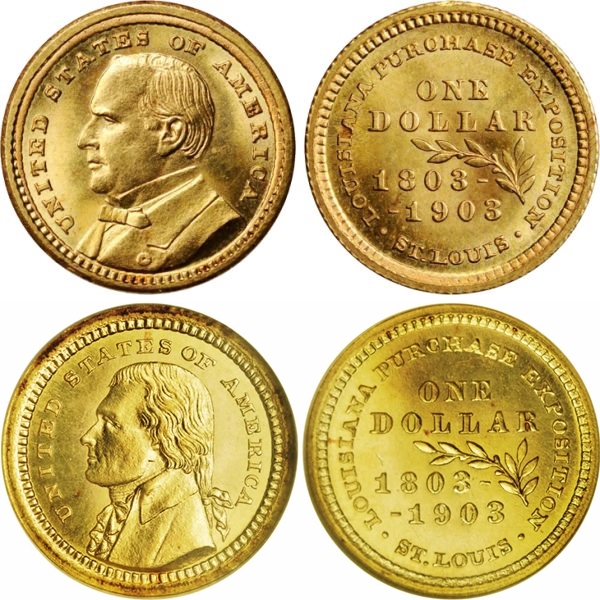
Louisiana Purchase 1903 Gold Dollars
On March 3, 1901 President William McKinley signed legislation calling for a Centennial Exhibition in St Louis to celebrate the one hundredth anniversary of the Louisiana Purchase in 1803. Unfortunately he would never see the celebration he called for because on Sept 1st at the Pan-American Exhibition, McKinley fell to an assassin’s bullet, dying thirteen days later.
It took until June 28th 1902 before Congress got around to passing an appropriation of five million dollars to pay for the exhibition. Included in that bill was a clause calling for two hundred and fifty thousand dollars worth of the appropriation to be paid out in commemorative gold dollars. The coins were to be dated 1903 in keeping with the centennial and the opening of the exhibition that year. Then like most such grand events, things couldn’t get done on time so the Centennial celebration of the Louisiana Purchase of 1803 was held 101 years later from April to December 1904.
Chief Engraver Charles Barber designed the coin. The reverse was quite simple and in fitting with Barber’s talents. In a circle around the outer rim is the inscription LOUISIANA PURCHASE EXHIBITION ST LOUIS. In the center the denomination One Dollar is spelled out in two lines at the top and the centennial dates 1803-1903 are in two lines at the bottom. A small olive branch serves to separate the two inscriptions. The obverse is simply the legend UNITED STATES OF AMERICA arching over a bust. The bust was to be that of Thomas Jefferson, the President at the time of the purchase. For some reason though two different obverses were created. Although there is no official documentation ordering it to be done, half of the coins were struck with the Jefferson bust and the other half with a bust of William McKinley.
In December 1902 the first 75,000 coins were struck with the balance of the authorized mintage being coined in January 1903. They were offered for sale for $3 apiece but sales were terribly slow. There was, as of yet, no exhibition for it to be a souvenir of, the official presentation case was just a pasteboard box with some cotton wadding in it. But mainly the price was higher than the average person could afford to pay for a souvenir, not to mention twice as much if they wanted both of them. The $6 price was roughly the equivalent of a weeks pay for the average person. To try and move more of the coins several gimmicks were used. They were bundled with souvenir ¼ and ½ “Louisiana Gold” tokens with the tokens being half price. Once the exhibition finally opened they were sold mounted as stickpins, broaches, bracelet charms, or in spoons. All of them mountings had the coin solder into the holders, but they were also sold with an assortment of mounting that would allow the coin to be removed.
Despite all the gimmicks, sales were bad. In fact they were worse than bad, they were horrible. At the end of the exhibition after almost two years of sales, only 35,000 coins were sold. The two different types were sold in roughly equal numbers so 17,500 of each design existed and the rest of the dollars went back to the mint or melting. Even those figures are too high though because many of the coins wound up in those soldered mounting permanently damaging if not destroying the coin.